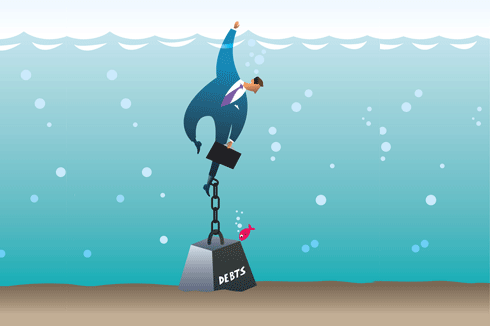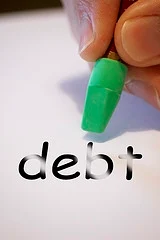Debt Relief and Debt Elimination

Get rid of your debt faster with debt relief
Choose your debt amount
Or speak to a debt consultant 844-731-0836
- 6 min read
- Understand that different ways the term 'debt elimination' is used.
- Review the legitimate ways to eliminate debt and achieve debt relief.
- Avoid any firm that tells you that you can wipe out all your debt without paying anything back.
- Start your FREE debt assessment
Don't Fall for a Debt Elimination Scam.

If you are seeking debt relief, you are not alone. Unemployment, the rising cost of living, stagnant wages have placed American households under increased financial strain. Eliminating debt is a healthy and reasonable goal. The key question is how to go about achieving debt relief.
An important first step to getting out debt, is to understand how the terms "eliminate debt" and "debt elimination" are used. Sometimes, they are used as catch-all terms that are applied to a number of different approaches for debt relief. Other times, they are used to refer to a specific, purported way to get out of debt that is really a scam. This method is called "debt elimination." If you don't understand the terms, you could end up getting scammed by a bogus debt solution.
Debt Coach
There are a number of proven ways to achieve debt relief. Each one has its own positive and negative aspects. Bills.com has a new, free tool, Debt Coach, that allows you to compare the five main ways of eliminating debt. Debt Coach gives you a customized comparison, based on your specific financial situation. You specify your goals and priorities and Debt Coach gives you a recommendation tailored to your needs.
Debt Relief Options
The main approaches to eliminating debt are:
- Optimized payments- Optimizing your payments is a strategy to get out debt that you can do on your own, using your money more effectively to pay off your debts. Two optimized payment strategies are "debt snowball" and "debt avalanche." Debt snowball targets your lowest balance debt first, giving you a psychological boost when you pay off your first debt. Debt avalanche targets your highest interest debt first, which saves you more money over the long haul. Both approaches work best when you maintain the same total monthly payment towards your debts, even after you pay a debt off.
- Debt Consolidation- Debt consolidation is another term that is used broadly, so you need to pay attention to how it is used. Strictly speaking, debt consolidation is where you take out a new loan and use the proceeds to pay off other lenders. Examples of debt consolidation are cash out refinancing on your home or using a balance transfer offer from a credit card company. While a debt consolidation loan can lower your interest rate and provide one easy payment, you need very good to excellent credit to qualify. Also, you won't qualify for a cash-out refinance on your home, unless you have sufficient equity. Turning unsecured debt into secured debt is a negative factor of a cash-out refinance, as it places your home at risk, should you be unable to make your payment and it can also keep you trapped in your home, unable to sell or refinance, if the value of your home drops below the amount you owe on your mortgage. A balance transfer offer could be helpful, but the low interest teaser rate is temporary. Also, if you miss a payment, your interest rate will skyrocket. Debt consolidation is also used to describe professional debt resolution services that do not truly consolidate your debt, but consolidate your payment.
- Credit Counseling- Credit counseling is a program that starts with a thorough financial review. If, after going over your income and expenses, your debt counselor feels that your debt problem is serious, he or she may recommend that you enroll in a debt management plan. The primary benefits of a debt management plan are that it can result in lower interest rates and a lower monthly payment. A debt management plan consolidates your payment, but not your debt. You make one payment to the credit counseling firm, which distributes your money to your various creditors. It is important to understand that in a credit counseling program, you are still repaying 100% of your debts, but with lower monthly payments. The lower interest rates allow you to speed up the time it takes to get out of debt. On average, most credit counseling programs take around five years.
- Debt Settlement Debt settlement, also called debt negotiation, is a an aggressive form of debt relief. Debt settlement is the fastest and cheapest way to get out of debt while avoiding bankruptcy. Your savings can be as much as 50% of the debt you enroll and debt settlement programs will significantly reduce the size of your monthly payments. Debt settlement programs are not for everyone, but they are well worth considering if you have a serious financial hardship that makes it so you either cannot pay your bills or are about to start falling behind on them. Debt settlement programs typically take three years to complete. It is important to keep in mind that during the your debt settlement program, you are not making monthly payments to your creditors. This harms your credit rating and can lead to collection efforts by your creditors, but is a necessary step to break the monthly payment relationship in order to achieve reduced balance settlements. New FTC rules make debt settlement more attractive for consumers. Debt settlement firms that solicit your business over the phone are not legally allowed to collect a fee from you until they have settled a debt for you. Attorneys that negotiate settlements and firms that meet with you face-to-face can charge up-front fees, but a savvy consumer can avoid up-front fees by working with a reputable debt settlement firm that is FTC compliant.
- Bankruptcy- Bankruptcy is usually considered a debt relief option of last resort. Bankruptcy is a public matter. You need to stand in public and declare that you are unable to pay your debts. Public notices are published. Your credit report will show that you filed for bankruptcy for at least seven years and for as long as 10 years. Since the bankruptcy laws were reformed in 2005, it is much harder to qualify for Chapter 7 bankruptcy that can eliminate your debts. You may only qualify for a Chapter 13 bankruptcy. In a Chapter 13 bankruptcy, your debts are reorganized. The debts are repaid, according to the terms established by the bankruptcy court. Chapter 13 bankruptcies usually run three to five years.
Debt Elimination
Debt elimination firms confuse consumers by using quasi-legal language and by claiming that their approach has worked for others. They often claim that their approach is government approved. According to a Special Bulletin issued by the Federal Reserve , "some of the documents specifically refer to the elimination of debt through the use of a 'Federal Reserve approved' procedure. Debt elimination programs that claim Federal Reserve approval or acquiescence and the satisfaction of legitimate debts through the presentation of suspicious documents are totally bogus. The Federal Reserve does not approve and is in no way involved in any program aimed at eliminating anyone's debt obligations. These schemes are proliferating on the Internet, and the organizers are charging borrowers substantial up-front fees and commissions based on the total amount of debt that can be forgiven. Members of the public are being harmed as borrowers generally pay significant amounts of money without eliminating or reducing their overall debt obligations - which of course is not in fact possible through any of these programs."
Debt elimination does not offer the consumer debt relief. Debt elimination leads to money wasted on fees and a debt problem that gets worse, instead of better. RUN AWAY FROM DEBT ELIMINATION and focus on the legitimate ways to achieve debt relief.

Get rid of your debt faster with debt relief
Take the first step towards a debt-free life with personalized debt reduction strategies.
Choose your debt amount
Or speak to a debt consultant 844-731-0836